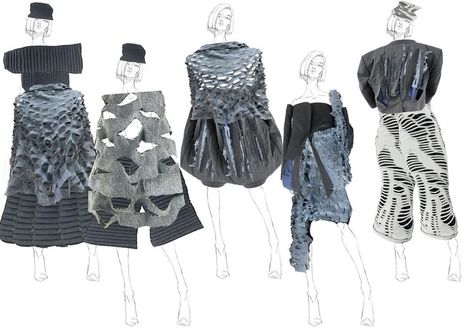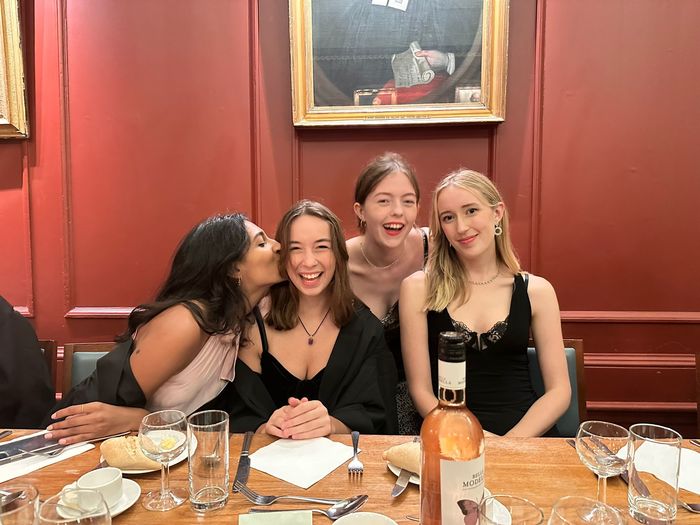Looking to the future of fashion
Hannah Drayton explores the role of AI in shaping the fashion collections of the future

From Valentino’s collection of digital clothing for metaverse avatars to Vetements’ “anti-AI” SS24 collection, the fashion world is equally fascinated and horrified by generative AI. Extensive discussion exists around the benefits and potential existential threats that AI poses to the creative industry, but I want to focus on how AI interacts with fashion in its capacity as “wearable art”. While fashion initially embraced the novelty of AI, it is now beginning to reject it as the enemy of creativity, turning instead to a more humanistic approach.
Haute couture is regarded as the pinnacle of fashion. It is the branch of fashion most in line with “art”, and perhaps the furthest from “wearable” because of its far-from-everyday design and its impossibly small clientele (around 4,000 people worldwide). Specific requirements must be met for a fashion house to earn the title of haute couture. They must create custom outfits in an atelier with at least 15 employees and present full collections of at least 50 designs twice a year in Paris. The highly skilled seamstresses who handcraft every piece are referred to as les petite mains, a testament to their extraordinary dexterity. Couture is steeped in tradition and is increasingly struggling to keep up with the modern world.
“Couture is steeped in tradition and is increasingly struggling to keep up with the modern world”
Clothing is a fundamentally physical thing. It is not a 2D creation designed for the screen, but something that testifies to the intricate technique required to construct the walking artworks of couture. However, this form of fashion is inaccessible to the vast majority of people. Most people only ever see these works on a screen, and social media does mean that anyone who wants to engage with the fashion world now can. So does it matter if the designs never exist outside of the digital? Or is there a fundamental difference between seeing a product of data, unshaped by human hands, and seeing the culmination of real people’s skill and creative passion? AI fashion, beyond the initial interest in its composition, tends to leave people feeling less connected and compelled by what they are seeing. Just look at the extensive customer backlash to cult brand Selkie’s use of AI-generated art for their new collection. In an age where technology threatens to replace everything, sharing in human creativity, personal experiences, and technical excellence seems to mean more to people than ever before.
“In an age where technology threatens to replace everything, sharing in human creativity, personal experiences, and technical excellence seems to mean more to people than ever before”
This is the background of Daniel Roseberry’s January 2024 haute couture collection, inspired by the tension between human creativity and technological production. Roseberry commented to Vogue: “I’ve even seen, online, people taking my work and doing AI interpretations and asking, ‘Who did it better?’” This has driven him to explore the childlike parts of himself and create from a place of imagination and fond personal memories, something that a machine simply cannot do.
Perhaps the most notable dichotomy between man and machine in Roseberry’s collection was the “robot baby”, constructed from bedazzled pieces of outdated tech and carried like an accessory by one of the models (apparently intended as an otherworldly homage to the classic film Alien). This motherboard baby is a novelty constructed from once new but now old innovations, capturing something quite disquieting. While a mother holding a baby would typically symbolise natural creation and growth, here it becomes something unnatural, provoking questions like: “what the fuck would that labour have looked like?” The machines that make up its skin, now antiquated despite only being 20 years old, serve as a reminder of how far and how quickly technology has developed into this sprawling thing that knows all. The baby is a symbol of unnatural potential. This technological child can grow and achieve so much, which is equal parts exciting and eerie. Roseberry’s baby is spectacular in its beauty and combination of two very different modes of creation – natural versus technological – as well as being so ludicrous that no AI would ever have come up with it.
Roseberry’s collection has been incredibly successful, provoking interest and evoking emotion in many people. Could this collection, or indeed this connection, have been made so well without Roseberry’s personal inspiration and the testament to human skill and capacity it represents? Designers’ rejection of AI makes complete sense, as outsourcing creativity to it means losing all opportunity to create themselves. This is no doubt something that they would find incredibly difficult, having trained and worked their whole lives for the opportunity to share their creativity with the world.
AI can nonetheless lead to immense advancements. Stella McCartney’s collaboration with Protein Evolution Inc., a plastic recycling company, aimed to create indefinitely reusable textiles through AI-designed enzymes. The fashion industry creates too much – there are too many trends that move too quickly, too many fast fashion brands recreating too many runway looks, and people buy and throw away too many clothes – and this overproduction is greatly fueled by technology. We really don’t need AI to start contributing more to the near-instantaneous creation of limitless designs, while the human element gets increasingly lost. McCartney and PEI’s work may offer a better image of how AI can help to reduce, rather than contribute to, fashion’s excessive creation. The future is AI and the future is now, but embracing its potential does not have to mean letting go of the creative outlet and means of sharing personal identity that fashion has always been.
 News / Cambridge students set up encampment calling for Israel divestment6 May 2024
News / Cambridge students set up encampment calling for Israel divestment6 May 2024 News / Cambridge postgrad re-elected as City councillor4 May 2024
News / Cambridge postgrad re-elected as City councillor4 May 2024 News / Some supervisors’ effective pay rate £3 below living wage, new report finds5 May 2024
News / Some supervisors’ effective pay rate £3 below living wage, new report finds5 May 2024 Fashion / Class and closeted identities: how do fits fit into our cultures?6 May 2024
Fashion / Class and closeted identities: how do fits fit into our cultures?6 May 2024 Features / Cambridge punters: historians, entertainers or artistes? 7 May 2024
Features / Cambridge punters: historians, entertainers or artistes? 7 May 2024






